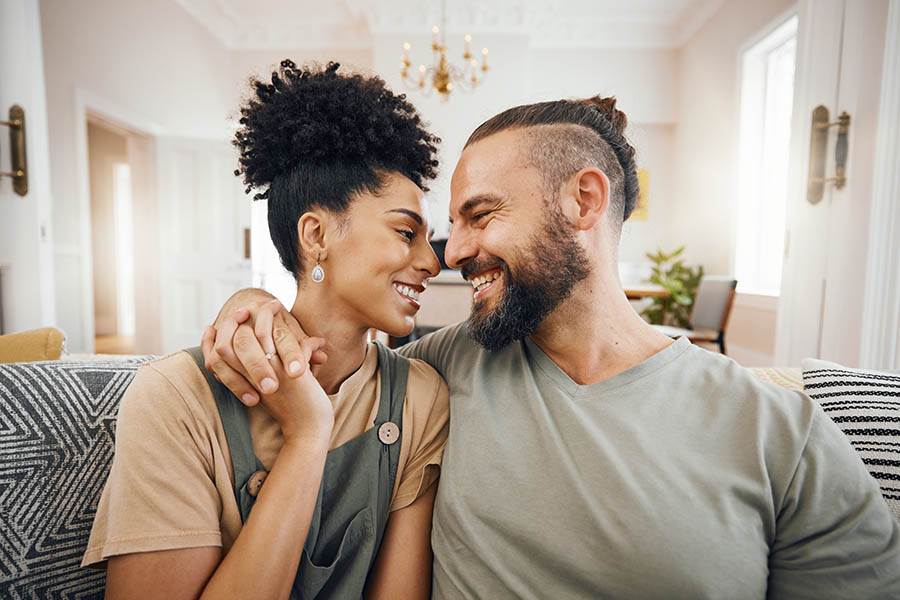Attachment Styles and How They Impact Our Relationships by Psychic Jenna
Date 10/23/2024
Explore More:
Romance

Psychic Jenna explains the different styles of attachment and how they can come into play in our relationships.
Navigating relationships is undeniably challenging. Whether you've experienced the joys and trials of long-term commitment or are venturing into new situations and connections, relationships demand dedication, compromise, and substantial emotional investment. However, beneath the surface, lies a fundamental aspect that influences relationship dynamics: attachment style. This deeply ingrained, subconscious pattern not only shapes how we connect with others but also influences the course and success of our relationships. Deeply rooted in science, attachment theory highlights the fundamental importance of our attachment styles and how they impact our relationships, including the typical patterns that will subsequently emerge.
In this article, we will dive deeper into the essence of attachment styles, their impact on relationship dynamics and longevity, and practical ideas, tools, and tips for cultivating secure and healthy attachments. Understanding and recognizing your own attachment style (and that of your partner) can be transformative for both individuals and the relationship, offering a pathway to deeper emotional connection and overall relationship harmony.

What are the Four Attachment Styles?
Attachment styles, which are comprised of four distinct categories - secure, anxious, dismissive avoidant, and fearful avoidant (disorganized) - dictate how we engage and connect emotionally with partners. Three of the four attachment styles are known as “insecure” forms of attachment (Anxious, Dismissive Avoidant and Disorganized/Fearful Avoidant) while secure attachment is viewed as the healthiest and most fulfilling attachment style.
Formed early in life (childhood) through interactions with caregivers, these styles reflect our fundamental approach to intimacy and closeness. Childhood experiences, such as consistent nurturing, or neglect and trauma, significantly mold these styles, laying the foundation for our adult behaviors within relationships.
How Are Attachment Styles Formed?
Our attachment styles, and how we connect with others on an emotional level, are formed in our early youth, when we’re still infants and small children. Our relationship with our caregivers, and more specifically, how our caregivers interacted with us as infants plays a significant role in affecting how we interact with partners in our adulthood, and how we connect with them. Thus, your earliest bonds in life will eventually affect your future romantic relationships.
If, as a child, you were cared for by a consistent, loving, supportive, and nurturing caregiver who paid attention to your needs, you’re more likely to develop healthy, stable, and secure relationships as an adult. Consequently, you would likely develop a secure attachment style. However, if your caregiver was inconsistent with love or affection, neglected your needs (emotionally or physically), was abusive, or showed disinterest, you are likely to develop an insecure attachment style. These early patterns will likely continue into adulthood unless changes are made.
According to attachment theory, the first 18 months of your life are the most influential in forming your attachment style. However, other relationships and situations can also impact this. Past friendships and early relationships can affect how you respond to emotional cues and handle difficult situations or conflicts. For example, if you experienced heartache or betrayal, even a child with a secure attachment style may develop an insecure style due to the trauma. Trauma can impact how you connect with your romantic partner and how you respond to them as well.
Each attachment style is unique. You may find that you perfectly fit into one category, or you may find that you have elements of one, but not all. Remember that each person is an individual and with very specific traits and characteristics. Attachment styles are generalizations, but they do not embody the depth of the individual.
Can You Change Your Attachment Style?
Sometimes attachment styles will change depending on the situation or partner. For example, someone who previously displayed a secure attachment style may develop an anxious attachment style if paired with a dismissive avoidant partner - someone who often struggles with emotional intimacy and closeness and tends to pull away.
Conversely, someone with an anxious attachment style can become more secure after being in a healthy relationship for a period of time. Depending on the situation or the partner, your attachment style can change or be impacted. You may also find that you don’t completely "fit" into any one category and instead have elements of more than one attachment style. While attachment styles aren’t a “one-size-fits-all” approach, they provide a general view of how people connect and form attachments within relationships, offering insight into the reasons behind their behavior.
While attachment styles typically remain stable once established (meaning that they tend to carry on throughout someone’s life, like a pattern), they aren't set in stone. With intentional effort, understanding, patience and perseverance, individuals can grow from insecure to secure attachment patterns over time. Change IS possible with work and consistency. This transformation not only enhances and promotes personal well-being but also fosters healthier, more fulfilling relationships.
Something important to remember is that much of the behavior impacted by your attachment style is not purposeful or conscious. Actions taken in relation to attachment style aren’t necessarily conscious or well-thought-out decisions. They’re impulses, tendencies and patterns. Due to the subconscious nature of how they present, it’s extremely important to understand how they develop, and how to work consciously and intentionally to grow into healthier, happier and more sustainable relationship behavior.

Attachment Styles and Relationship Longevity
When considering longevity within a relationship, attachment styles play a considerable role in determining how individuals navigate their connections. Those with an anxious attachment style may find themselves staying in relationships even when they're toxic or unhealthy, driven by a persistent need for validation and love that can unintentionally adversely impact even healthy partnerships. Those with anxious attachment styles often struggle with self-worth and with confidence, they deeply fear abandonment and will often show behavior others may consider “needy”, “clingy”, or obsessive, when they’re genuinely trying to feel safety and security within their relationship. However, the way they go about it can unfortunately drive even healthy partners away.
On the other hand, individuals with a dismissive avoidant attachment style often struggle with long-term commitment and emotional intimacy, even in mutually compatible and extremely loving relationships. Someone with a dismissive avoidant attachment style may show vulnerability, closeness, and connection early on, but after a period of time (generally 4-6 months though it can vary) will tend to pull back, reduce affection, and avoid emotional intimacy. They often struggle with communication and have a deep-seated fear of conflict, making resolving issues difficult to sometimes impossible.
Have you ever observed someone who repeatedly cycles through breakups and reconciliations or reacts intensely during conflicts, only to later express deep regret and fear of losing the relationship? Such behaviors often stem from a disorganized or fearful avoidant attachment style, marked by emotional inconsistency and a push-pull dynamic. People with disorganized attachment styles often deeply fear abandonment but can also push people away as a result (sort of like, “I’ll abandon you before you can abandon me” if you will). At the same time, they can also show traits similar to those with anxious attachment styles and crave closeness and validation. This can create an extremely confusing dynamic for the other partner.
These examples highlight how insecure attachment styles can pose challenges over time. In contrast, individuals with a secure attachment style tend to cultivate lasting, healthy relationships characterized by trust, security, and emotional closeness. They do not struggle with emotional intimacy with others, connect in a meaningful and vulnerable way, and tend to have a healthy sense of self confidence, as well as are relatively good at setting boundaries. Relationships with someone with a secure attachment style can feel very stable, supportive, and nurturing, fostering trust and emotional intimacy.
In this next section, we’ll dive into each attachment style and what they present like!

Anxious Attachment Style
The anxious attachment style, also known as “anxious-ambivalent” or “anxious-preoccupied,” is characterized by a deep fear of rejection and abandonment. Individuals with this attachment style often struggle with self-esteem and frequently feel undervalued or unappreciated. They not only desire connection but also fear losing it, which can make them appear "clingy" or "needy." They often require constant validation and regular reassurance that the relationship is secure.
People with an anxious attachment style are often raised by caregivers who were inconsistent in their care and attention. These caregivers might have been sensitive and supportive at times but nonresponsive or misattuned to the child's needs at other times. For example, a parent might be warm and affectionate on some occasions but cold, distant, and unavailable at other times. Parents who avoid or are slow to console a crying infant or child, refusing to hold or care for them in times of distress, may unintentionally foster an anxious attachment style in the child, which can persist into adulthood.
Those who have anxious attachment styles can struggle with maintaining relationships as they often unintentionally exhaust or overwhelm partners due to the extreme need for security. While we all need security and stability, people with this attachment style tend to feel a stronger fear and thus have a stronger reaction to perceived threats to the relationship. Sometimes the fear of abandonment and fear of rejection can be so strong that it can overpower or control the relationship.
If you’re someone that struggles with an anxious attachment style, the good news is that your patterns, your reactions, and your own emotional regulation can improve over time with consistent work on healing. You can absolutely learn healthier ways of connecting with your partner through individual therapy (with a clinical psychologist or mental health professional), self-healing work, trauma work, and through acceptance, patience, and learning new ways to regulate your emotions and energy.
When in a relationship with someone who has an anxious attachment style, it's crucial to understand that their reactions and fears, though sometimes exhausting or frustrating, are expressions of their need for connection. They don’t intend to be overwhelming, but individuals with this attachment style often struggle to feel secure even with a stable partner.
Showing empathy, patience, and increasing validation can ease the tension and pressure unintentionally caused by anxious attachments. While you don’t need to fulfill every request, creating a safe environment for open communication and fostering emotional well-being can greatly support those with this attachment style. Anticipating their need for validation and encouraging them to explore the underlying roots of their fears can also be extremely beneficial.

Dismissive Avoidant Attachment Style
Dismissive avoidant attachment styles present significant challenges, marked by complexity and difficulty. Individuals with this attachment style tend to avoid closeness and struggle to form or maintain connections within relationships. They often resist emotional intimacy and fear vulnerability, displaying minimal emotional expression. Communication about feelings and needs can be particularly challenging for them, and they tend to avoid or withdraw from conflict, even gentle disagreements or expressions of need from their partner. Dismissive avoidant individuals struggle with supporting others' emotional needs and prioritize independence in relationships.
Consequently, relationships with someone with this attachment style can feel distant or lacking in depth. Despite these challenges, individuals with dismissive avoidant tendencies still crave love and connection like everyone else. However, their development of dismissive tendencies can make it difficult for them to fully trust or open up in relationships.
Individuals with this attachment style often exhibit strong self-sufficiency. They hold themselves in high regard, which can lead them to be critical of others at times. They may also appear as though they don’t "need" or even want a relationship, yet they often deeply care for and love those they are in relationships with. This complexity makes it a challenging attachment style to navigate.
Dismissive attachment styles typically arise when primary caregivers were not affectionate, lacked emotional connection, or actively avoided closeness with the child. Emotional neglect is a common cause, though abuse in any form can also contribute to this attachment style. A heartbreaking reality for people that were born into emotionally neglectful households is that unless they make conscious effort to improve how they connect with others, they will struggle with how the commit and connect to others until they address those deeper childhood wounds.
A common and interesting dynamic occurs between individuals with an anxious attachment style and those with an avoidant attachment style. People with an anxious attachment style are often unconsciously attracted to individuals with an avoidant attachment style in an attempt to fulfill deep emotional needs stemming from childhood. Those with avoidant attachment styles can and likely will appear secure and engaging in relationships initially, displaying affection and communication with ease due to the lack of emotional triggers. Early stages typically proceed smoothly without conflict or commitment issues, making it easy for dismissive avoidants to enter into such relationships.
However, as the relationship progresses - either with time or changes like increased commitment such as moving in together, engagement, or marriage - dismissive avoidants may feel triggered and begin to distance themselves. Triggers can range from anything that feels too emotionally close to anything that’s perceived as criticism. While dismissive avoidants may sometimes be accused of 'love bombing' before pulling back, this behavior is not intentional. It stems from deep emotional wounds that require acknowledgment and healing on a subconscious level.
If you have a dismissive avoidant attachment style, there are several ways to enhance your ability to connect more deeply with your partner and others, free from fear. You're not trapped, and there's no need to remain alone indefinitely. Exploring your past to understand how it shaped your current self can be immensely valuable in uncovering the root causes of your behavior. With this awareness, integrating mindfulness practices and engaging in trauma-focused therapy and self-help efforts can significantly boost your chances of developing more secure attachments in your life.
If you’re in a relationship with someone that’s dismissive avoidant, it can feel like a complex puzzle you can never win. You may struggle with having your emotional needs met, feel like your partner is intentionally distancing themselves, and see delays or issues with commitment.
There ARE things you can do though to help support your dismissive avoidant partner and improve your relationship! Setting boundaries with regards to how you want to be treated and your needs, providing space for your partner to process, and approaching conflict as calmly and gently (and slowly) as possible. Don’t avoid conflict, change how you approach it instead. Creating a safe space for your partner to open up when they’re ready, but not pushing them towards it can help establish increased trust and connection.

Disorganized / Fearful Avoidant Attachment
The disorganized or otherwise known as “fearful avoidant” attachment style is a bit of a combination between the anxious and the avoidant attachment styles and is also known to be the rarest form of attachment and one of the most difficult to manage. People with disorganized attachment styles can be extremely confusing and contradictory, and deal with complex emotions and emotional dysregulation within relationships.
Individuals with this attachment style have significant difficulty with maintaining stability, frequently displaying unpredictable behaviors. They can often sway between being overly attached and needy to being very dismissive and ambivalent. Their behavior can vary depending on the person or situation, often appearing contradictory. This is because they truly desire a deep intimate relationship yet are simultaneously afraid of being in a relationship. Their emotions and their ways of processing appear “disorganized” as they’re not consistent.
As we’ve already seen, people with anxious attachment will tend to do everything that they can to stay in a relationship, even ignoring toxic behavior or blatant red flags in order to sustain the relationship. Avoidant people tend to be the opposite, pulling away from emotional intimacy and feeling a deep need for independence and space or avoiding commitment. Someone with a disorganized attachment style, being a combination of the two, will display both of these behaviors. Meaning that they will often deeply fear losing the relationship, want emotional closeness and connection, but then pull away and self-sabotage (thus sabotaging the relationship).
Disorganized attachment styles typically stem from specific early childhood traumas, particularly when a caregiver becomes a source of fear for the child. This can occur through direct abuse or witnessing abusive behaviors toward others in the household, including physical, sexual, or verbal abuse.
Despite these traumatic experiences, the child still forms attachments to the caregiver but struggles with uncertainty and unpredictability in the relationship due to the abuse. As a result, the child learns to perceive relationships as unsafe, unstable, and unhealthy. While they yearn for close connections and love, they lack the necessary skills to feel secure within relationships, carrying the burdens of their childhood into adulthood.
Individuals with a disorganized attachment style experience relationships as a blend of fear and love. They may alternate between feeling clingy and obsessive one moment and needing significant space and distance the next. Emotionally, this presents a considerable challenge as they navigate intense feelings and struggle with regulating their emotions and self-soothing. Their behavior can be unpredictable, sometimes lashing out at their partner despite craving closeness and connection. Trusting others poses a significant challenge, leading them to appear conflicted and uncertain in relationships, often unsure of how to proceed. Individuals with this attachment style typically have lower self-esteem, engage in negative self-talk, and may harbor excessive suspicion toward romantic partners.
If you have a disorganized attachment style and aim to develop more secure attachments, practicing self-regulation and stress-relief techniques alongside mindfulness can be highly beneficial. Therapy may also be essential to address past trauma, while learning to communicate openly and vulnerably can effectively release pent-up emotions. It's important to take space when necessary, without withdrawing completely, as withdrawing may unintentionally create distance in your relationship. Prioritizing your emotional needs while maintaining connection with your partner is key to fostering a healthier dynamic.
If you’re in a relationship with someone who has this attachment style, you’ll likely notice a pattern of pushing you away and then pulling you back in. This can create a roller-coaster effect where stability feels elusive due to intense emotions that manifest through clingy and obsessive or avoidant behavior. Dealing with such intensity can be challenging, as individuals with disorganized attachment struggle with emotional regulation and trust issues, leading to suspicion and over analysis of their partner’s actions. This instability can leave you feeling unable to establish a secure and peaceful connection.
However, there are proactive steps you can take to support both yourself and your partner in this situation. Clear, open, and consistent communication can significantly alleviate difficulties. Providing a safe environment for your partner to express themselves without judgment is crucial. Patience and understanding are essential, as any perceived criticism may trigger withdrawal. Couples therapy is highly recommended for those with disorganized attachment styles, offering a calm, non-judgmental space to learn healthy relationship techniques.

Secure Attachment Style
The secure attachment style is known as the healthiest of all attachment styles. Someone who displays this style will often show consistency, have little problem with building trust within the relationship, display a desire for connection and closeness, and will not pull away from emotional intimacy (they generally embrace it). Individuals with secure attachment styles will often communicate their needs and desires well, will often form effective boundaries, and are often willing to seek help or assistance if needed.
Secure attachment styles are formed in early childhood, like the other styles, except the caregivers showed consistent love, support and nurturing during key developmental periods. If you have a secure attachment style, your parent or caregiver was likely consistent, displayed love and affection regularly, responded to your needs and encouraged you to explore your interests. Your parent or caregiver likely expressed their emotions in a healthy way, and did not control, abuse, or neglect you. Secure attachment can also be learned over time, through self-discipline, mindfulness and self-awareness.
Forming More Secure Forms of Attachment
If you or (your partner) have discovered that you struggle with an insecure form of attachment, the wonderful news is that it doesn’t have to remain that way if you don’t want it to. There can absolutely be meaningful and positive, lasting change if you’re intentional with your efforts. Below is a list of things that you can do to help yourself to become more secure in your attachments:
- Work on communication. Communication is key to ALL relationships, but when dealing with insecure attachment styles, open, honest, and vulnerable communication is necessary. Improve how you approach communication, and even communicate with your partner on how you WANT to communicate! Try to find time to open up to your partner in any way that feels comfortable to you but try to do it consistently. Over time, communicating won’t create the anxiety and tension that it previously did, and you’ll find that it releases stress and tension, and helps avoid confrontation and conflict.
- Dig into your past. It’s often difficult to confront the realities of our upbringing, or to analyze why we have become the way we are now. Especially in cases where you’ve experienced trauma or neglect, yet still understand, care, or love the caregiver/parent who caused the trauma. Exploring your past does not mean you have to relive it, the goal is to understand why you are the way you are, and how to move forward knowing that information. Dig into your past to find information and solutions, not excuses. Inner child work might be a good place to start.
- Set boundaries and expectations based on your needs. Learn to set healthy boundaries that are effective (stay away from ultimatums). Communicate with your partner about how you want to be treated, and how you want to be talked to. Set expectations for yourself on how you want to treat your partner as well.
- Make the effort to learn your love languages and your partner’s love languages. Learn how you recognize and accept love, and how you feel most loved. Learn how your partner recognizes and accepts love, and prioritize your partner’s needs and love languages. Seek mutual consideration within the relationship.
- Seek compromise and communication as opposed to conflict when triggered or stressed. In any argument or conflict, seek compromise and understanding, and stay on point. Set boundaries around conflict so that arguments and fights stay on point, fair, and healthy. No name calling, no insults, no hurtful words. Seek to address the problem itself and find a mutually agreeable solution.
- Begin a mindfulness practice. Start incorporating mindfulness into your daily life and activities. Mindfulness is a key practice for overcoming trauma and moving forward from difficult past experiences and can be massively helpful for learning and adapting to new, healthy mindsets. Practicing daily silent meditation (under 10 minutes) can be extremely helpful in promoting mindfulness.
- Patience and consistency. Be patient with yourself and allow the changes to occur naturally. Be consistent in any changes and be persistent through challenging emotions. A huge benefit to this consistency is that your partner will likely mirror your positive changes and incorporate them as well.

Helping Your Partner Form More Secure Forms Of Attachment
If you’re in a long term or committed relationship with someone with an insecure attachment style, it can be challenging and difficult to maintain stability. You can feel isolated, alone, or overwhelmed and controlled. Below is a list of things that you can do to help support your partner in improving their insecure attachment style.
Keep in mind, however, that in order for genuine change to be made, your partner will need to desire the change, understand their attachment issues, and resolve to improving them. It does require work on the individual’s part, you cannot “force” someone towards a healthier mindset, but you can help positively influence them towards positive change.
- Start with yourself. What is your attachment style? Do you have an insecure attachment style that needs to be addressed as well? What areas can you improve to help create more stability and consistency in your life? Practice self-healing and make sure to address issues that you bring to the table.
- Create a healthy level of independence within the relationship. This does not mean to pull away or pull back from your relationship. However, you are an individual within the relationship, and it’s important to not to lose yourself in the connection. Make sure to create space and time for your own interests, ventures, and things that bring you joy. Make sure that your relationship is not the sole source of your joy, fulfillment and entertainment.
- Communicate as clearly as possible. Be transparent in how you address issues. Communicate about communicating with each other! Communicate about conflict, and how you want to approach future conflict and address it. How do you want problems or difficulty brought up? How can things be brought up without becoming triggers? Communicate about how you respond to stress, anxiety and difficult emotions, and how you want to communicate when in times of distress and what you may need. Have bi-weekly check-ins where you have mutual time to bring up unresolved issues, problems, or anything that needs to be addressed but is being held back. Identify triggers and talk about how to manage them with your partner. Encourage your partner to help you understand their needs. Be okay with being vulnerable when communicating.
- Give some space. ESPECIALLY if you’re dealing with an avoidant or someone with a disorganized attachment style, it’s very necessary that you give them space to process. They may need time regularly to exercise their independence, so make sure to allow time for decompression. Communicate with your partner about their need for space, and compromise when it comes to length and frequency.
- Provide validation. For those with anxious attachment styles, validation is something that’s extremely important to help reduce anxiety and tension. Take additional time to focus on them, ask questions, and gain insight into what makes them feel the most secure.
- Learning to address conflict in a healthy manner. This means being extremely accountable, and not allowing conflict to go to unhealthy levels. Deflect any negativity that is directed at you, understand that it comes from a place of trauma and fear, and provide space and understanding. Don’t tolerate abuse but learn to healthily de-escalate conflict as it arises. Communicate once conflict is over, to readdress any left-over concerns or hurts (those with avoidant attachment styles often have difficulty with returning to previous arguments due to deeper insecurities and shame, thus they need to learn how to more fully resolve conflict instead of avoiding it).
- Set appropriate boundaries and expectations with how you want your partner to treat you, and how you want to treat your partner.
- Maintain a mindfulness practice and help incorporate mindfulness into your daily life. During times of tension or discord within the relationship, a mindfulness approach can help reduce the stress you experience and how you react to any given situation your partner presents. Meaning you’ll be more grounded and able to control how you respond.
- Learn more about your partner’s attachment style. How they fit into that mold, and how they don’t. Take an active approach in learning about their background and childhood, and how their experiences impacted them over time. Don’t become an “armchair psychologist” and attempt to “treat” your partner but do take an active interest in understanding why they are the way they are. You will likely find unique ways of helping them, identifying with them, and working with them through their troubles and stress.
- Therapy. Individual therapy and couples/marriage counseling can be extremely effective and helpful in overcoming problems stemming from insecure attachment styles within relationships. Having someone that’s balanced, non-judgmental, and a neutral party involved can help with seeing things from an objective perspective. Individual therapy can be the most helpful with addressing your own issues, but couples counseling can be equally helpful if your partner is unaware of their attachment style or difficulty with accepting it.

Having a specific attachment style doesn’t doom you to a life of unfulfilled or overly challenging relationships. Knowing your attachment style can help you gain a deeper understanding of who you are, and how you became the person you are today. It can also help you to identify where some of the tendencies and patterns you display come from, and how to begin addressing them and improving them. Every relationship can improve and reach a healthier, happier, and more fulfilling level of connection, including the one you have right now.
If you’re having difficulty with attachment issues, want to learn more about attachment styles, or have a partner who is displaying an insecure attachment style, feel free to reach out to me (Jenna) at extension 3604 and I’d love to help in any way that I can.
